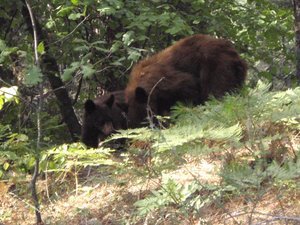Advertisement
Published: September 19th 2008

 Mummy Bear & Baby Bear
Mummy Bear & Baby Bear
Female bear with one of the cubs looking for their supper“Teddy Bears Picnic” - Sequoia National Park, California 17th/18th September 2008
Once upon a time, American Black Bears were paraded in the Sequoia at a spot called “Bear Hill’ for the benefit of tourists; they were also introduced to the taste of human food. Subsequently, bear attacks on people became common-place as they raided rubbish bins and caused damage to cars. The bears then had to be shot. In the 1950s, the Sequoia had a petrol station, restaurants, holiday cabins and hordes of tourists who went to molest the wildlife. Today, all of these buildings have been removed (the last one in 1990) and the bears are left to roam wild and free and thus rarely seen by visitors. The huge Sequoia trees (cousins to the coastal Redwoods but much larger and thousands of years old) were also damaged by countless tourists trampling on the ground around their roots and damaging seed growth. Today, the Sequoia is a peaceful paradise, with groves of the remaining giant trees meticulously guarded by rangers on patrol, camping limited, no fuel stations or cafes and the wildlife is protected.
We spoke to many people but none had seen any bears; we got

 Looking for food
Looking for food
The female bear, injured on her left shoulder. Although called American Black Bears, their colour can be anything from blond to black. She is a rich brunnette and her mate and cubs are black.lucky! At about 5 p.m. after the heat of the day had declined and the evening coolness was just settling in, we spotted a family group. We were all on our own (the summer hordes having long gone from the high sierras) and kept very still and quiet. The photos are not great because the bears were quite elusive so we got several shots of bears in the shadow of trees or their backsides as they foraged for food. They were not bothered by us; they were more determined to find food. The male, large and black, was well-hidden most of the time but he was probably watching us very closely. The two cubs were black but the female was brown; she was injured and limping badly. She had a shoulder wound. After our bear encounter we drove down to the ranger station and reported the sighting and injury. The ranger made an immediate phone call to a colleague and we just hope that they can help her before winter sets in. We’ll never know. We thought that the Grand Canyon couldn’t be beaten, but having the privilege of seeing a family of wild bears is a truly memorable experience.

 Daddy Bear
Daddy Bear
Very large, very cautious and very hard to photograph!Our two days in the Sequoia provided a peaceful respite after two days of travelling and gave us a chance to walk in the forests unhindered. We saw several “Douglas Squirrels’, which are tiny, and two deer. We hardly saw any people. We are now further North close to Yosemite, where we are planning to spend a whole week before heading back to San Francisco.
Advertisement
Tot: 0.294s; Tpl: 0.016s; cc: 22; qc: 99; dbt: 0.1484s; 1; m:domysql w:travelblog (10.17.0.13); sld: 1;
; mem: 1.2mb

 Mummy Bear & Baby Bear
Mummy Bear & Baby Bear
 Looking for food
Looking for food
 Daddy Bear
Daddy Bear










